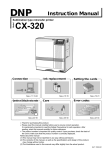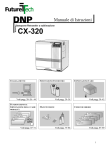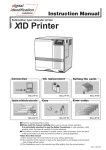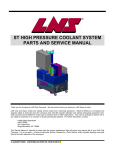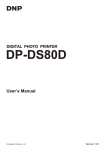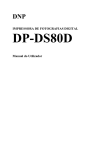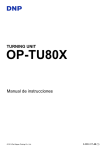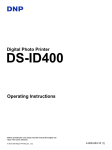Download DNP CL-500 Instruction manual
Transcript
DNP Instructions Card Laminator Model Name CL-500 Installation Setting Film Operation and Settings >>cleaning OK? >Cleaning Power save 60 >Mode:Single MENU Ready See pages 8 - 10 Error Messages See pages 11 - 12 See pages 13 - 14 Maintenance Tu r n o v e r e r r o r Card Jam (Out) HR Overheat Overcool No Cassette See page 17 See pages 19 - 20 ● Thank you for purchasing our product. ● Before operating this unit, please read the instructions carefully to ensure the best possible performance. Be sure to read “Notes for safe operation” and use the unit safely. Keep the instruction manual in a safe place and read it when necessary. ● The manufacturing number is important for quality control. Please check whether the manufacturing number on the back of this unit is correct during the purchase. Notes regarding this manual (1) The contents of this manual shall not be reprinted or redistributed in any form without prior consent. (2) The contents of this manual or the specifications and external appearance of this unit may be altered without prior notice. (3) Illustrations used in this manual may differ slightly from the actual shape of this unit. KAT- T173-002 Declaration of Conformity Model Number: CL-500yyyyy(y=A-Z,0-9 or blank) Product name: Card Printer We herewith declare that the above mentioned product complies with the following council directives and harmonized standards. Council Directives: 89/336/EEC relating to electromagnetic compatibility. 73/23/EEC relating to electrical equipment designed for use within certain voltage limits. Harmonized Standards: EN55022:1994+A1:1995+A2:1997: Class B EN55024:1998+A1:2001+A2:2003 EN61000-3-2:2000 EN61000-3-3:1995+A1:2001 EN60950-1:2001 Importer and distributer: DAI NIPPON PRINTING CO.,LTD. 1-1 Ichigaya-kagocho, 1-chome Shinjuku-ku, Tokyo 162-8001 Japan Phone: +81-3-3266-3344 Facsimile: +81-3-3266-2732 Manufacture Victor Data Systems Co.,Ltd. 2969-2, Ishikawa-cho, Hachioji-shi, Tokyo 192-8620 Japan Year to begin affixing CE Marking: 2004 Hachioji-shi, Dec.21.2004 Place, Date Tateki Hisanaga General Manager-Quality Control Victor Data Systems Co., Ltd. 2 Information for USA NOTE: This equipment has been tested and found to comply with the limits for a Class B digital device, pursuant to part 15 the FCC Rules. These limits are designed to provide reasonable protection against harmful interference in a residential installation. This equipment generates, uses and can radiate radio frequency energy and, if not installed and used in accordance with the instructions, may cause harmful interference to radio communications. However, there is no guarantee that interference will not occur in a particular installation. If this equipment does cause harmful interference to radio or television reception, which can be determined by turning the equipment off and on, the user is encouraged to try to correct the interference by one or more of the following measures: – Reorient or relocate the receiving antenna. – Increase the separation between the equipment and receiver. – Connect the equipment into an outlet on a circuit different from that to which the receiver is connected. – Consult the dealer or an experienced radio/TV technician for help. Caution: Changes or modifications not approved by party responsible for compliance could void user's authority to operate the equipment. Machine noise Sound power level: less than 70dB(A) according to DIN45635 part 19 (EN27779). The measurements are to be made according to DIN45635 part 2019 or EN27779, respectively. 3 Introduction Characteristics of this Unit ● This is a laminating machine connected to a card printer, whereby it adheres a protective layer over the surface of a card printed by the printer. ● A hologram can be created on the adhesive protective layer, thus increasing the security level of the card. ● It is not necessary to control this unit via the printer as it receives and laminates the card automatically according to settings. ● Connecting a communication cable between this unit and the printer permits communication with the printer. Table of Contents Notes for safe operation ............................................ 5 Before Using ............................................................... 7 Checking accessories ............................................... 7 Handling the film ....................................................... 7 Cards that can be used ............................................. 7 Location for installation ............................................. 7 Installation .................................................................. 8 Part Names ............................................................... 8 How to install ............................................................. 8 Mounting the Stacker ................................................ 9 Setting the Voltage toggling switch ........................... 9 Connecting the Power Cord ...................................... 9 Installing a cable between units .............................. 10 Preparation and Starting ......................................... 11 Mounting the Film ................................................... 11 Power On ................................................................ 12 Exchange the film ................................................... 12 Operation and Settings ............................................ 13 Control Panel Display and Operation ...................... 13 User Mode Settings ................................................ 14 Troubleshooting ....................................................... 15 Internal Structure .................................................... 15 Settings for Laminate Condition .............................. 16 Error Code List ........................................................ 17 Removing Jammed Card ........................................ 18 Improper winding of film .......................................... 18 Film discoloration .................................................... 18 Maintenance ............................................................. 19 Cleaning the Transport Roller (Cleaning Card) ....... 19 Cleaning the Filter ................................................... 19 Cleaning the cassette ............................................. 20 Once Laminator servicing and cleaning have been completed ............................................................... 20 Specifications ........................................................... 21 4 Notes for safe operation Before you use Read these notes on safety thoroughly before operating your printer in order to use the unit properly. Once you start using the unit, this manual should be put aside the unit, or at a convenient place where you can look up the manual any time as you need. WARNING CAUTION ● If you ignore the warning with this mark, and handle the unit in a wrong way, death or serious injuries may occur. ● If you ignore the caution with this mark, and handle the unit in a wrong way, injuries or damages to properties may occur. WARNING 䡵 If the abnormal phenomena as listed below are seen, immediately stop operating the unit. Continuing operation may cause a fire or electric shock. • Smoke or odd smell comes out from the machine. • Water or metal went into the machine. • The unit fell to the floor, or the cabinet was broken. • The power cable is damaged (exposed lead, broken cable, etc.) If you see these phenomena, turn off the power, pull out the power plug, and contact your dealer as soon as possible. Do not try to repair it by yourself. It is dangerous. 䡵 Do not remove the screws, or disassemble or alter the machine. • High-voltage components are contained in the unit. Touching these areas may result in an electric shock. • Ask your dealer if you want the unit inspected or repaired. • Do not remove the external covers of the machine. You may get an electric shock. 䡵 Do not work on the power cable, or give excessive force on it. Do not put heavy objects such as furniture on the cable. • The cable may be damaged, causing a fire or electric shock. • When you find a defect on the power cable, such as exposed lead, stop using the unit, and consult your dealer. 䡵 Do not use the machine with the power plug inserted incompletely. • The machine generates heat due to incomplete contact, causing a fire or electric shock. • Do not put many cords on a single plug socket. The power cords also heats up. 䡵 Do not use the machine with dusts piled on the power plug. Do not put a metallic material adjacent to the power plug. • Dusts and metal are conductive, causing a fire or electric shock. • Pull out the power plug from the outlet every six months, and clean the dusts piled on the legs and body of the plug. 䡵 Do not use a line voltage other than instructed. • Using a line voltage or power supply which is not specified may cause a fire or electric shock. 䡵 Do not put foreign materials from the openings of the machine (e.g., vents, card slots, cassette inlet, etc.) • Metals, flammable things, and other foreign materials may cause a fire or electric shock if entering into the machine. • If these things went into the machine, immediately turn off the power, pull out the power plug, and ask your dealer to repair. Do not try to repair it by yourself. It is dangerous. 䡵 Do not put a container with liquid in it, or small metal ornaments and the like on the machine. • The liquid or metal entering into the machine acts as a conductor, causing a fire or electric shock. • If liquid or metal went into the machine, immediately turn off the power, pull out the power plug, and ask your dealer to repair. Do not try to repair it by yourself. It is dangerous. 䡵 Do not place the machine on a rickety table or slanting places. • The machine may fall out of the table or fall over, which may damage the machine or injure you. • If the machine is damaged by falling or turnover, immediately turn off the power, pull out the power plug, and ask your dealer to repair. Do not try to repair it by yourself. It is dangerous. 䡵 Do not wet the machine with water. • Using the machine at a place where water splashes on the machine, or wetting the machine with water (applying, throwing, or spilling water over the machine) may cause a fire or electric shock. • If water entered into the machine, immediately turn off the power, pull out the power plug, and ask your dealer to repair. Do not try to repair it by yourself. It is dangerous. 䡵 Do not touch the machine with wet hands. • Touching the machine with wet hands may cause an electric shock. 䡵 Do not touch the power plug during electrical storms. • Lightning may cause an electric shock. 5 Notes for safe operation (continued) 䡵 Ground the machine with the attached electric cord when connecting it to the utility outlet. • Using a cord other than the one supplied for grounding may cause an electric shock when the machine fails. 䡵 Do not put your head or yourself into the packaging bag. 䡵 Do not use the machine while it has a fault. • Do not use the machine while it has a fault, as this may cause a fire or electric shock. • Immediately turn off the power, pull out the power plug, and ask your dealer to repair. Do not try to repair it by yourself. It is dangerous. • Do not play with the packaging bag. You may suffocate yourself. • Give close attention to small children who may want to play with the packaging bag. CAUTION 䡵 Pull out the power plug before cleaning the machine. • This is for preventing electric shocks. 䡵 Pull out the power plug when you won’t use the machine for a prolonged period of time to assure safety. 䡵 Do not put the machine at a place where it becomes excessively hot. • The surface and internal components may deteriorate. Also there is a danger of a fire. Special care should be taken for exposure to direct sunlight or a heater adjacent to the machine. • Remove the power plug from the outlet for safety when you won’t use the machine for a long time. 䡵 Hold the body of the power plug when pulling it out. 䡵 Do not move the machine with the power cable and other electric cables connected. • Do not pull out the plug by holding the cable. The cable may be broken or damaged which may in turn cause a fire or electric shock. • The cables may be damaged while being moved, which may cause a fire or electric shock. • You may stumble over the cable and get injured. 䡵 Do not move the machine with objects placed on it. • They may fall on you and hurt you. 䡵 Do not put heavy objects on the machine. • They may fall on you and hurt you. 䡵 Do not block the vents. • Heat generated inside the machine cannot escape, which may cause a fire. 䡵 Inspection • Ask you dealer or a qualified person to inspect the machine, typically once every two to three years. Operating the machine with dusts piling on the components for a prolonged period of time may cause a fire or a malfunction of the machine. It will be particularly effective to inspect the machine before wet rainy season. Consult your dealer on the costs of inspection. 䡵 Do not put the machine at a place where it will be wet with steam (e.g., from a humidifier), or at a excessively humid or dusty place. • The oil, water and dusts act as conductors, which may cause a fire or electric shock. 6 䡵 Do not touch the power plug with a wet hand • You may get an electric shock. 䡵 Do not lay the power cable near the heating equipment. • The covering of the cable will melt due to heat from such equipment, which may cause a fire or electric shock. 䡵 The heat rollers and adjacent areas become hot during operation. • Be careful not to touch the heat rollers and adjacent areas when replacing the film cassette, or remove jammed cards. • Wait until the heat rollers get cooled down to prevent burns. 䡵 Be careful of jamming your hand or fingers in the card stacker, or front door. • Replace the film cassette, or remove jammed cards with care not to jam your hand or fingers in the mechanism, which may cause an injury. 䡵 Do not use a power cable other than the specified cable for connection. • If you use an unspecified power cable for connection or extension, heat may accumulate in the cable, causing a fire. Before Using Checking accessories Location for installation Check the accessories that come with this unit when unpacking. Refer to page 21 “Specification” for the contents of accessories. There are ventilation holes for cooling fans at the rear of this unit and the sides and rear of the printer. Place the unit such that the sides are away from the surrounding walls as shown in the diagram. The rear should be at least 20 cm away from the surrounding walls. Do not place any objects above this unit. Do not place objects on top At least a distance of 20 cm At least a distance of 20 cm Handling the film ● Be careful not to touch the surface of the film directly with your hands as this will result in adhesion failure. ● If foreign particles are stuck onto the film surface, these will be absorbed into the adhesive layer and become impurities. Install the film under a clean environment. ● When replacing old film with a new one that was stored under low temperature, leave the new film for more than one hour in an environmental temperature where it is to be used. Using a new film directly will result in condensation and cause adhesion failure and jams. ● Storage method Storage environment : In a packed condition Temperature 5 ˚C - 25 ˚C Relative humidity less than 50 % Avoid locations with direct sunlight or highly humid locations. Storage period : Use it as soon as possible after opening. Cards that can be used ● External dimensions: 85.4 mm (L) x 54.0 mm (W) x 0.76 mm (D) ISO 7810 compliant card Refer to the printer manual for the material of the card and other handling methods. 7 Installation Part Names Front Front Door Front Door Mounting the Film Removing Jammed Card ¥ See page 11 ¥ See page 18 Control Panel Control Panel Display and Operation ¥ See page 13 Power Switch Power On ¥ See page 12 Power Input Terminal Control Panel (switch for Europe model only) Connecting the Power Cord ¥ See page 9 External Connection Terminal Installing a cable between units ¥ See page 10 Film Cassette Mounting the film ¥ See page 11 Power Switch How to install Rear Caution Be careful not to pinch your fingers when installing. 1. Mount the printer onto the attatched unit joining plate PRINTER OPTION FRONT Power Input Terminal Optional Connection Terminal Printer Connection Terminal When the printer door is open FRONT Film cassette 2. 8 Install the laminator (Next page) Caution Turn the power off before connecting the cable between the printer and laminator. Otherwise some malfanction may be caused. Note If the mounting is uneven, the card would not be Connecting the Power Cord Connect the attached power cable to the power input terminal. The suplied power cable varies depending on the shipment destination and model. Use the power cable in accordance with each area. transported smoothly. Be sure to fit the units right in. Always install the unit at a horizontal and hard surface location. Mounting the Stacker Mount the card stacker that comes with the printer. Card outlet For AC120V (North America) Claw For AC220V - 240V (Europe) Card stacker receptacle Stacker Note Caution Be sure to hang the card stacke claw on the card stacker receptacle, not the card outlet. If you mount the card stacker at a wrong place, cards are not ejected,resulting in a card jam. Setting the Voltage toggling switch Always use a dedicated power supply with earth terminal for the power socket. Do not share the power socket with other electrical power equipments. Use AVR (Automatic Voltage Regulator) when there is possibility of voltage variation. Use of an uninterruptible power source instead of AVR is recommended when there is possibility of momentary power interruption. (For Europe model) Switch the voltage toggling switch above the power input terminal according to the power voltage to be used. (Factory setting: 220 - 240V) INLET 50/60Hz 220 - 240V ~ 100 - 120V ~ 230V 220 - 240V 100 - 120V Voltage toggling switch Caution It is extremely hazardous if voltage is set incorrectly Although there is a protection feature, pay attention when setting the voltage as a precaution 9 Installation (continued) Installing a cable between units The unit connecting cable is an optional accessory. 1. Connecting with CX210 As shown in the diagram, connect the cable to the [OPTION2] external connection terminal of the printer and the [PRINTER] external connection terminal of the unit. OPTION2 PRINTER 12 pin 9 pin Connecting cable Tight the screw after connecting Caution Turn the power off before connecting the cable between the printer and card laminator . Otherwise some malfunction may be caused. 2. Connecting with CX-120 Insert the cable into the “LAMINATOR” external connection terminal at the printer and the “PRINTER” external connection terminal at the laminator, followed by fastening the cable with the screws provided. LAMINATOR PRINTER 9 pin 9 pin Connecting cable Tight the screw after connecting 10 Preparation and Starting (Next page) Mounting the Film 1. 4. Open the front door Grasp the protrusion at the top of the door and pull it open. Hold the corner of the door to open it more easily. Insert the film and winding bobbin into the cassette Insert the bobbin holder all the way in while paying attention to the direction of the film as indicated by the seal instructions on the cassette. Lever Film cassette Film Winding bobbin Guide shaft 2. Bobbin holder Remove the film cassette Push the lever to eject the cassette. Remove the cassette while supporting it with both hands. Note When removing the cassette for cleaning purposes,always stand it as shown in the figure. Allowing the film surface to touch the grund will dirty the film and result in adhesion failure or jams Note Transport cusion When the film is mounted, ensure that loose film do not sag to the inner section when pulling out the cassette. Note Replace the transport cusion putting under the cassette, and keep it for transporting the laminator next time. 3. Place the end of the film 5. Wind the film once around the winding bobbin Turn the winding bobbin with film more than once around in the arrow direction. Stand the film and winding bobbin side by side on a clean table without dust, place the beginning of the film to the winding bobbin. Remove the label of the lamination film and place on it to the surface of the winding bobbin. Caution Ensure that the film is parallel when placing it on the winding bobbin. If the film is placed in a slanted direction, sticking of the laminating film will also be slanted and a film detection error may occur. Check that the film is properly wind. 11 Preparation and Starting (continued) 6. Note Insert the cassette To avoid interruption to the laminating operation, Knob observe the following items strictly. ● Do not open the front door and take off the cassette. ● Do not switch off the power. ● Do not unplug the power socket. Stopping the device during operation will cause the card to be stuck inside the device and result in jams. While holding the film so that the film does not sag, insert the cassette all the way in against the guide rail. When it is fully inserted, a click sound will be heard. And the cassette will be locked with the lever. Exchange the film Exchange the film keeping the power on ,in the same way as “Mounting film”. When the film is already mounted, turn the knob of the cassette in the direction of the arrow to the tighten loose film. Guide rail Knob Guide shaft Caution Pay close attention to the position for insertion as the guide shaft is shorter than the edge of the cassette. Inserting into the wrong position by force may damage the device. Caution Do not put the film cassette on the back of the door for mounting. Do not rest your elbows or put any heavy object on the back of the door as it may break. Execute the reset operation, after setting the cassette. --> See page 13 When the film exchanged under the power off, execute the initialize operation after the power on. --> See page 13 Power On Check that the connection between the units is correct, then switch on the power of this unit previous to the printer. Caution When connected with the printer, correct information will not be displayed on the LCD until the printer is turned on. Caution The internal section reaches a high temperature when the power is already switched on and the heater warmed up. Be careful not to touch areas with the caution labels. Note When the film is mounted, ensure that loose film do not sag to the inner section when pulling out the cassette. 1 12 2 Operation and Settings (Next page) LED display Control Panel Display and Operation Manual Operation Buttons MENU RESET/ MENU READY ERROR EXIT ENTER LCD display area LED display area Manual Operation Buttons area Enter the user mode The LED displayed --> See page 13 as below. ENTER Confirmation of the Light on operation Blinking EXIT Light off Cancel of the operation RESET Reset button Turning on the power READY ERROR Boot up READY ERROR Film exchanged? EXIT ENTER Initialize.. READY ERROR Preheating.. READY ERROR Ready READY ERROR 1. Booting up and checking the status 2. Check whether film was exchanged or not Initialization of the film is required if the film has been changed. 2 LEDs will blink simultaneously and wait for input. EXIT ENTER Press button for initialise the film. If button is pressed, the initialization of the film will not be performed. If it left in no operation 20 second after power on, the initialization of the film EXIT will not be performed same as button having been pressed. 3. Displayed during the Initializing process If ENTER button is pressed, the initialization of the film will be performed. 4. Displayed during preheating After the power is switched on, the unit remains in preheating state for about 3 to 4 minutes. 5. Ready status after preparation is complete. Reset operation RESET READY ERROR Reset OK? EXIT Initialize.. 1. Press the reset button. ENTER READY ERROR LCD operation display content READY Ready 2. Confirm that the reset to be performed or not. ENTER Press button to perform the initialization. EXIT If it was mistake, disengage by pressing button. 3. Displayed during the Initializing process 1. Ready status See the following for other display Mode setting screen --> See page 14 Error Notification screen --> See page 17 Maintenance --> See page 19 ERROR Loading READY ERROR Laminating READY ERROR Turn off the power 2. Displayed during feeding 3. Displayed during laminating (The Lamination is done up on the surface on the card ) It will change to Ready status after the laminating operation has done. When select pass through mode, LCD shows still Ready and Ready LED brinks. Turn off the power with confermation that laminatiing operation has been completed. 13 Operation and Settings (continued) User Mode Settings Press the MENU button to enter User Mode when the machine has stopped operating such as when it is in a ready or error state. MENU ENTER Select the operation by button, and confirm with button. The parameter will be changed by pushing RESET button in cyclic. ENTER Push button to confirm the parameter, and make a confirmation that the LCD display shows the message such as Data Saving.. MENU push EXIT button to return the previous situation. Factory settings Operation Mode ENTER RESET >Mode:Both >Mode RESET EXIT EXIT >Mode:Single >Mode:Pass Laminates on single side. single Laminates on duplex (Indicate when printer setting on CX-120). Allows the card to pass through without laminating. MENU Film type ENTER When using patch film of 1 mil thickness. >Film:1mil RESET >Film When using patch film of 0.6 mil thickness. >Film:0.6mil MENU 1mil RESET EXIT When using overlay film with no positioning marks. >Film:Overlay EXIT ENTER Patch position >Film Position >Film Position RESET Adjusts the patch transfer position -7 to +7 Lager the value the patch moves to right RESET Increases the temperature in steps of 5 ˚C between EXIT EXIT 0 MENU ENTER Temperature > Te m p > Te m p : 1 7 0 EXIT EXIT 170 120 ˚C and 180 ˚C MENU ENTER Lamination speed >Speed RESET >Speed:5.5mm/s EXIT EXIT MENU ENTER RESET EXIT EXIT 5.5mm/sec Card cooling fan >Card Fan Off >Card Fan Increases the speed in units of 0.5 mm/s between 4 mm/sec and 10 mm/1sec.The value that can be set may be limited by the combination with temperature. >Card Fan On Select the strength of card cooling fan required when Half laminating. 5 gradation can be set. [Off,Low,Half,High,Full] MENU ENTER >Cooling Time Card cooling before laminating >Cool time 0sec RESET EXIT Select the card cooling tine before laminating as 0, 5, 7, 10 seconds. 0 sec MENU EXIT Sleep mode ENTER >Power Save >Power Save:Off RESET >Power Save:30 EXIT MENU EXIT ENTER >LCD Contrast LCD Contrast >LCD Contrast:4 EXIT MENU RESET Power saving mode does not function. Lowers the heater temperature when there is no operation within a 10,20, 30 or 60 minute interval. Sleep Mode is automatically cancelled and the unit returns to preheating state when card loading begins. Adjusts the contrast of the LCD panel. Setting values are 1 - 5. EXIT ENTER EXIT MENU >Mode 14 Cleaning mode >>without HR >Cleanning EXIT Enter the cleaning mode As for the detail of cleaning mode -->see page 19 Return to the Operation Mode 30 4 Troubleshooting (Next page) Internal Structure Heater Cam position sensor (Part 2) Film sagging sensor Heater Cam position sensor (Part 1) Film cassette Film end mark sensor Film position sensor Laminate position sensor Card input sensor Card transport roller Cassette device Detecting switch Card ejecting sensor Heat roller Heater 15 Troubleshooting (continued) Settings for Laminate Condition Cards bend by influence of heat roller when laminate on such as PVC cards. Default setting for each film is decided due to the performance of PVC cards printed by CX210, and set automatically as to selection the film type. When the card bends is heavily. Or connecting with CX-120 that the printing method is different, please change the following settings after consults with your dealer. Example of Settings The recommendation setting values when connects with CX210 and CX-120, and performing single side printing of a PVC card is shown below. Notes: The PVC card has various kinds and optimal conditions differ, respectively. In order to pull out the performance of the Laminator to its maximum, please set it up after finding the best setting values. Connect with CX210 In case of CX210, the cards are heated in the printer previous to lamination, so it is important to adjust the setting of the printer in the optimum condition. Film 1mil Surrounding temperature CL-500 15˚C – 25˚C Temp Speed 5.5mm/s Card fan Half High Cool Time CX210 Retransfer 26˚C – 30˚C 170˚C 0sec Temp Temp 15˚C – 30˚C 15˚C – 30˚C 155˚C 130˚C 8.5mm/s 8.5mm/s Off Off 0sec 5sec -2 -2 +2 OFF Speed Cool overlay +1 Speed Bend Remedy 0.6mil OFF +2 +2 -2 0 0sec 0sec 0sec 0sec Connect with CX-120 There is no Bend Remedy function in CX-120. Therefore, the optimum conditions are set up in the combination of the setting item of Laminator. The example of a setup where adhesiveness was thought as important is shown in the following. Film Surrounding temperature CL-500 1mil 15˚C – 25˚C Temp 175˚C Speed Card fan 26˚C – 30˚C 7.0mm/s Half Cool Time High 0sec 0.6mil overlay 15˚C – 30˚C 15˚C – 30˚C 150˚C 130˚C 7.5mm/s 8.5mm/s Off Off 0sec 5sec When the laminated card surface warps concave The card surface tends to warp concave by laminating after printed single side by CX210. In that case, the Bend Remedy function of CX210 is effective. See the instruction manual of CX210 to set the bend remedy mode, after consults with your dealer. When laminating after printed by CX-120, also the card surface tends to warp concave. Please set the best setting values in the combinations of set items of Laminator, because CX-120 has no bend remedy function. When the laminated card surface warps convex The card surface tends to warp convex by the case of the cards are hot, for example laminating after printed both side by CX210 or the environmental temperature is high, and especially using 1mil patch. In that case, set the Card Fan mode of CL-500 up to more strengthen, after consults with your dealer. When print both side of the card by CX210, the Bend Remedy mode of CX210 should be set to OFF. When laminating after printed by CX-120, also set the Card Fan mode of CL-500 up to more strengthen. Note Inferior quality of laminated cards such as bad transfer or bending are out of guarantee. Make a enough test before deciding and using your cards on the consultation of your dealer. 16 Error Code List Error Code About the RESET ¥ ENTER button in the table After pressing the RESET button, press the ENTER button to initialize. If the condition does not recover even after the following actions, record the error message and call the service center. Contents of the Error Action Please Power Off To initialize this unit, the power supply must be switched off once. Switch off and on the power. Please Reset.. Displayed when Reset is necessary after changing the settings in User Mode. Press the Reset ¥ Enter button to initialize. Please Check Displayed altrnately when switch off and on the power on forcibly during lamination. Remove the caseete and check inside of the machine. If there is a card in the machine, remove it and push the RESET ¥ ENTER button to initialize the mavhine. Card Jam(In) Card Jam (Entrance area) Check whether the unit is properly joined to the printer. ¥ See page 18 ‘Removing Jammed Card’ Card Jam(Middle) Card Jam (Center area) The transfer temperature is too high or the speed is too slow. Consult your dealer for the most suitable setting method. ¥ See page 18 ‘Removing Jammed Card’ Card Jam(Out) Card Jam (Exit) The transfer temperature is too high or the speed is too slow. Consult your dealer for the most suitable setting method. ¥ See page 18 ‘Removing Jammed Card’ inside Film Detection Error Check whether the laminating film is correctly loaded. Press the Reset ¥ Enter button to initialize. Film has run out Replace the laminating film ¥ See page 12 Press the Reset ¥ Enter button to initialize. No Cassette No cassette Mount the film cassette correctly. ¥ See page 12 Press the Reset ¥ Enter button to initialize. Overcool Overcool HR is too hot! Cannot enter Cleaning Mode as the heat roller is too hot. ¥ See page 19 ‘Cleaning the Transport Roller’ Heater Cam error. There is an abnormality with the operation of the cam that controls the up and down movement of the heat roller. Switch off and on the power. The heater temperature does not rise. The heater is out of order. Or, check that there is no error in the voltage setting for models that come with voltage toggling switches. (For Europe model) Heater overheat Switch off the power immediately and call service center. Abnormal rising of internal temperature Switch off the power immediately and call service center. Abnormality in the heater roller temperature sensor Switch off the power immediately and call service center. Internal Memory Error Switch off the power immediately and call service center. Set Temp Err Abnormality in the heater roller temperature control Switch off the power immediately and call service center. R.Encorder Err Film Encoder Failure Switch off the power immediately and call service center. Film Search Film Run Out HR Cam Heater Err HR Overheat Overheat Temp Sensor Memory Err PRT.Communicate Communication error with the printer The environmental temperature for usage is too low. When activating the unit in a low temperature environment, the internal area of the device may be cold even though the surrounding has warmed up. Check the unit connecting cable and connect the cable certainly. 17 Troubleshooting (continued) Removing Jammed Card 1. Open the front door and pull out the cassette Turn the knob of the cassette in the direction of the arrow to tighten loose film before pulling out the cassette. Press the level and remove the cassette while supporting it with both hands. Lever Knob Caution When the card is stuck to the film, it may not be easy to pull out the cassette. In this case, pay special attention to the loose film and slowly remove the cassette such that the loose film does not sag from the cassette. Caution The area around the heat roller is very hot. Be careful not to touch areas with the caution labels. Caution When the cassette cannot be removed successfully, do not force it as this may damage the device. Contact your dealer. Improper winding of film 2. Turn the JOG dial to eject the card As shown in the diagram, insert a coin into the groove of the JOG dial and turn the dial to the desired side for ejection. When the film is in disarray due to accidents where the film is disenaged when a card is jammed or when pulling out the cassette, arrange the film neatly as shown in the following steps. 1. When there is no damage to the film Check that there is no damage to the film and with the film is still mounted on the cassette, wind the used-up film around the coiling bobbin. Install the cassette while the film is still tight. ¥ See pages 11,12 Jog dial 2. 3. Arrange the film neatly and insert the cassette into the unit See ‘Improper winding of film’ Ensure that the film does not sag when inserting. ¥ See page 12 4. Cut off part of the film with the damage and join the film with sticking tapes such that it becomes parallel. Install it in the same way as with a new roll of film. ¥ See page 11 Film discoloration Reset operation After the jammed card is removed, return the cassette to its original position and press the RESET button to cancel the error state. RESET/ MENU EXIT ENTER READY ERROR 18 When there is damage to the film If the “Ready” mode continues for a long time, the film may discolor by the heat of the heater. So it is recommended that when the laminator is not used the power is turned off or the Sleep mode is set. As a factory setting the 30 minutes Sleep mode is set. Maintenance Cleaning the Transport Roller (Cleaning Card) (Next page) 3. Most of the reasons for card jams is due to dirty rollers. It is recommended to clean the laminating machine at the same time when cleaning the printer roller. 1. Peel off the protective paper of the cleaning card and insert it into the card discharge slot. The card will be drawn into the unit by the rollers and cleaning will then be carried out. Insert the card with its adhesive face upside down to repeat the cleaning procedure once more. Cleaning card Enter Cleaning Mode Select >Cleaning in User Mode. ¥ See page 14 ‘User Mode Settings’ 2. Operation Mode Settings (1) Cleaning only the transport roller (normal setting) Press the ENTER button at the >>Without HR display. When >Cleaning OK? is displayed, press the ENTER button again. (2) Cleaning also the heat roller Remove the film cassette and pull the film and bobbin of the cassette. Note The cleaning card can only be used once. Using a dirty card over and over again will dirty the roller and result in jams. Consult your dealer for any queries regarding the cleaning card. Caution If the proper cleaning card is not used, the error message “Card Jam (Out)” is displayed Cleaning the Filter And insert the vacant cassette back. If the film is not removed >>Remove the film is displayed and no cleaning starts. Press the RESET button at the >>Without HR display. Select >>With HR and press the ENTER button. Press the ENTER button again to complete the preparation. When the heat roller is warmed up, HR is too hot! is displayed and cleaning cannot be performed. Switch off the power and wait for about 30 minutes for the heat roller to cool down before starting the operation. 1. Remove the filter cover Hold the upper and lower ends of the filter cover and pull forward to remove the filter cover. Filter cover 2. Clean the filter Remove dirt attached to the filter with a vacuum cleaner. While cleaning, press down the sponge to avoid it being sucked into the vacuum cleaner. 19 Maintenance (continued) Cleaning the cassette If the cassette is ejected and inserted repeatedly, the shaft of the cassette might rub against the front door causing dregs to adhere. This is not a malfunction. However, this may cause contact problem if the dregs adhere to the contact surface. When changing the film, make sure that no dregs adhere to the shaft. If dregs adhere to the shaft, wipe it with a dry cloth. At the same time, perform similar checking and cleaning on the insertion opening of the cassette. Shaft Caution Clean by cloth of thread dust free soak with dehydrated ethanol in such a distant place that no dust affects the laminator. When cleaning put the cassette on a flat table as when mounting the film, to avoid dropping the casstte or deformation of the shaft. Once laminator servicing and cleaning have been completed Once servicing and cleaning of the printer have been completed,check to make sure that all parts have been replaced propely. Improper replacement of parts may result in the power not turning on or operating errors. 20 Specifications Specifications Transfer method Transfer time : Halogen lamp built-in heat roller method : Approx. 20 seconds The time varies according to settings. : Temperature 15 ˚C - 30 ˚C Humidity 30 % - 70 % (without condensation) : Temperature –15 ˚C - 55 ˚C Humidity 20 % - 80 % : AC 100 - 120 V (tolerance ±10 %) for CL-500**U: North America model or : AC 220 - 240 V/100 - 120 V selectable (tolerance ±10 %) for CL-500**E: Europe model : Approx. 200 W : Approx. 8 kg Usage environment Storage environment Power supply Power consumption Unit mass Accessories : Power cord x 1 (for North America) for CL-500**U: North America model Power cord x 2 (for North America, Europe) for CL-500**E: Europe model Instruction manual Unit joining plate Cleaning card External dimensions diagram 207 310.5 RESET/ 13.2 MENU READY EXIT ENTER 290 308 ERROR Front Side Unit: mm * Design and specifications are subject to change without notice. 21 22 23 Card Laminator Distributor: DAI NIPPON PRINTING CO., LTD. 1-1 Ichigaya-kagacho, 1-chome Shinjuku-ku, Tokyo 162-8001 Japan Phone: +81-3-3266-3344 Facsimile: +81-3-3266-2732 CL-500 Instructions DNP
























